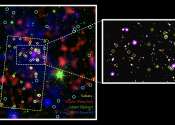Subaru Telescope (In Japanese: すばる望遠鏡) is the 8.2 metre flagship telescope of the National Astronomical Observatory of Japan, located at the Mauna Kea Observatory on Hawaii. It is named after the open star cluster known in English as the Pleiades. It had the largest monolithic primary mirror in the world from its commissioning until 2005.
Subaru is a Ritchey-Chretien reflecting telescope. Instruments can be mounted at a Cassegrain focus below the primary mirror, in enclosures on either of two Nasmyth focal points on the sides of the telescope mount, to which light can be directed with a tertiary mirror, or, in an arrangement rare on large telescopes, at the prime focus, in lieu of a secondary mirror, to provide a wide field of view suited to deep wide-field surveys.
- Website
- http://www.naoj.org/
- Wikipedia
- http://en.wikipedia.org/wiki/Subaru_Telescope
Some content from Wikipedia,
licensed under CC BY-SA
Subscribe to rss feed









